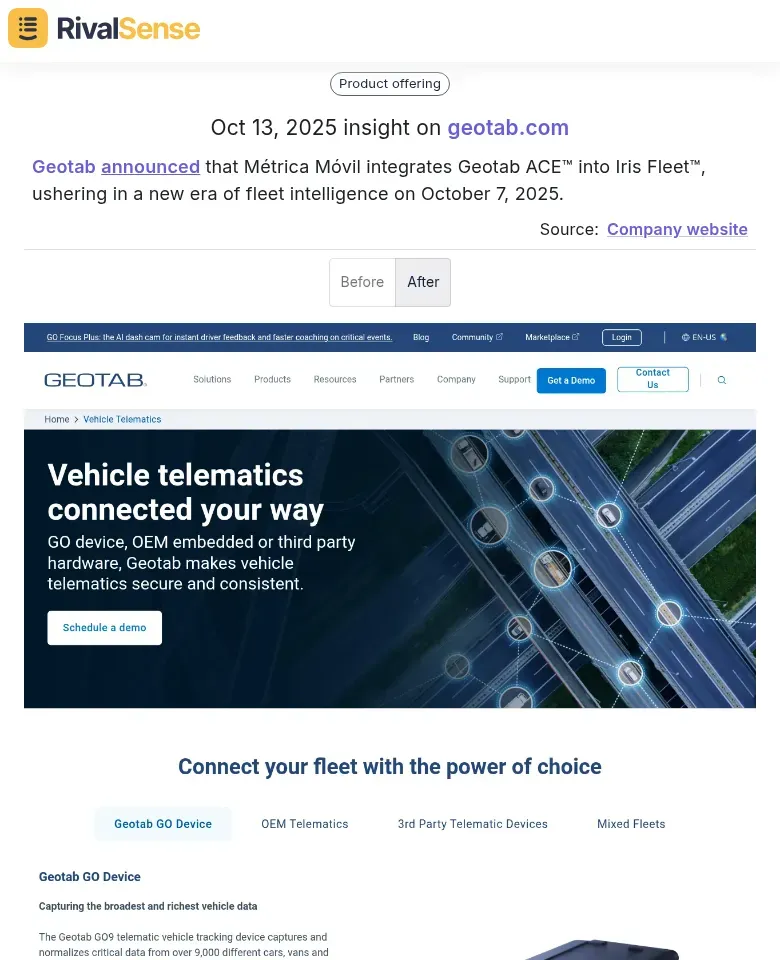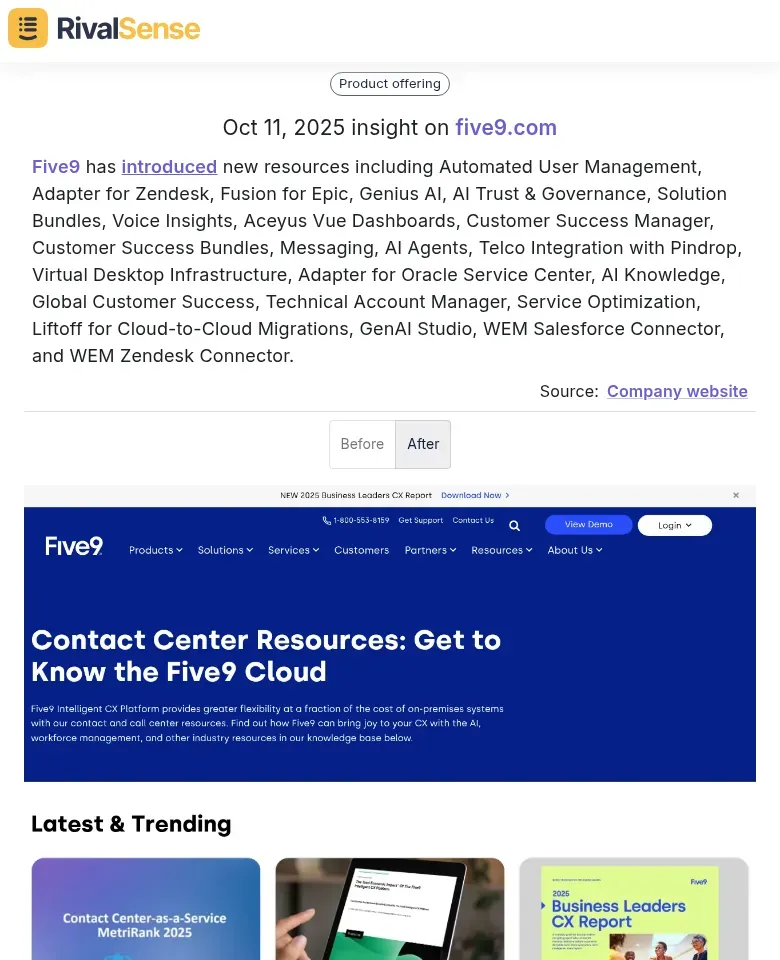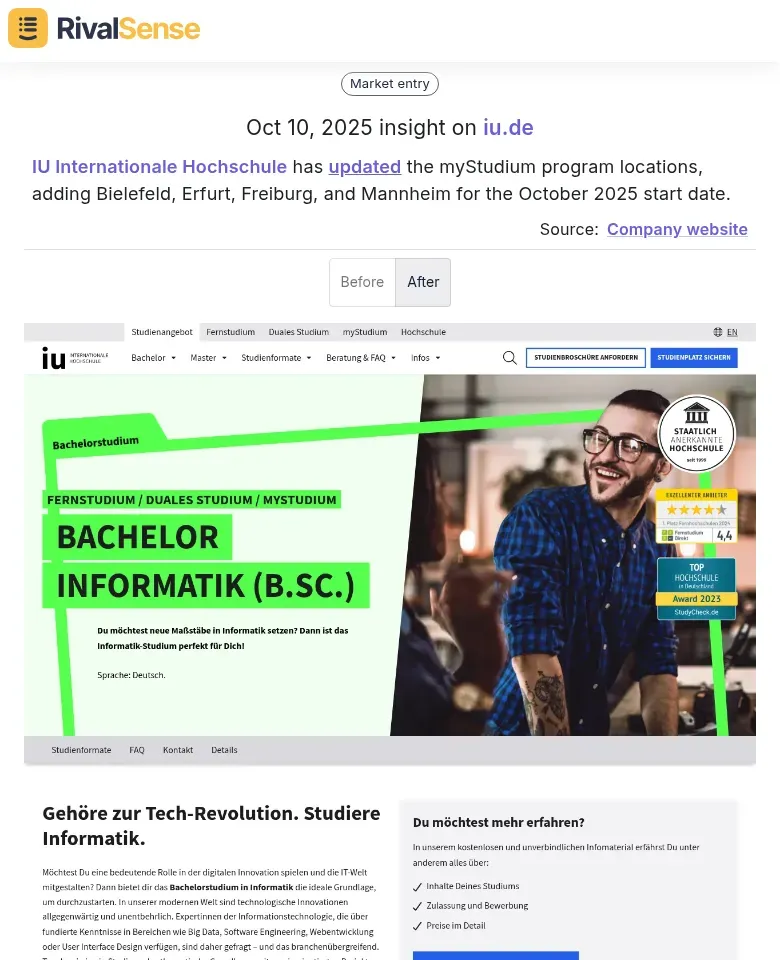Case Study: Website Changes Reveal Competitor Market Research
Website updates are real-time indicators of strategic shifts—every homepage redesign, feature addition, or content pivot signals your competitor's market research and expansion plans. For instance, when a rival adds a new pricing tier targeting small businesses, it reveals their intent to capture that segment. Tracking these changes proactively, rather than reactively, gives you a competitive edge. To start, monitor competitors' sites weekly for homepage layouts, product pages, and blog topics. Use tools like RivalSense to automate tracking and receive alerts. Create a checklist: note new features, removed sections, and messaging changes. Analyze patterns over time—are they emphasizing enterprise solutions or shifting to SMBs? This intelligence helps you anticipate moves, adjust your strategy, and stay ahead. Don't wait for announcements; decode the clues hidden in their digital footprint.
Partnership Announcements: Decoding Strategic Alliances and Market Positioning
Partnership announcements reveal strategic priorities and market positioning, offering a window into your competitors' collaborative efforts. When competitors announce new alliances, track the partner's industry, size, and technology to understand collaboration trends. For example, RivalSense recently tracked that Geotab announced Métrica Móvil integrates Geotab ACE™ into Iris Fleet™, ushering in a new era of fleet intelligence on October 7, 2025.  This type of insight is valuable because it highlights how partnerships can drive innovation and expand market reach, allowing you to anticipate competitive shifts and refine your own alliance strategies. Analyze integration features in announcements—seamless API connections or co-developed tools indicate technological advancement and commitment. Use these insights to predict competitive shifts: a partnership entering a new geographic market may signal expansion plans, while one focusing on niche verticals suggests targeted growth.
This type of insight is valuable because it highlights how partnerships can drive innovation and expand market reach, allowing you to anticipate competitive shifts and refine your own alliance strategies. Analyze integration features in announcements—seamless API connections or co-developed tools indicate technological advancement and commitment. Use these insights to predict competitive shifts: a partnership entering a new geographic market may signal expansion plans, while one focusing on niche verticals suggests targeted growth.
Practical Steps:
- ✅ Monitor press releases and social media for partnership news
- ✅ Evaluate partner profiles for market alignment
- ✅ Assess integration depth (e.g., single sign-on vs. full data sync)
- ✅ Update competitive intelligence reports with alliance impacts
Tips: Look for recurring partners to identify trusted networks, and note the announcement timing—it often precedes product launches or market entries. By decoding alliances, you can anticipate rivals' moves and refine your strategy accordingly.
Product and Feature Launches: Uncovering Innovation and Customer Focus
Product and feature launches reveal competitors' innovation priorities and customer focus, providing insights into their R&D direction. Tracking new features helps assess whether they're targeting efficiency, security, or user experience segments. For instance, RivalSense captured that Five9 introduced a suite of new resources, including Automated User Management, AI Agents, and GenAI Studio.  This insight is valuable because it uncovers emerging trends and customer needs, such as the push toward AI-driven solutions, enabling you to align your product roadmap with market demands. Analyze solution bundles and integrations for market segmentation insights; bundled tools often target SMBs seeking all-in-one solutions. Product updates also identify emerging customer needs—recurring security enhancements indicate growing data privacy concerns.
This insight is valuable because it uncovers emerging trends and customer needs, such as the push toward AI-driven solutions, enabling you to align your product roadmap with market demands. Analyze solution bundles and integrations for market segmentation insights; bundled tools often target SMBs seeking all-in-one solutions. Product updates also identify emerging customer needs—recurring security enhancements indicate growing data privacy concerns.
Practical Steps:
- 🔍 Monitor release notes and changelogs weekly
- 🗺️ Map features to customer pain points (e.g., automation for time-strapped teams)
- ⚙️ Use tools like RivalSense to track updates automatically
Tip: Compare feature velocity—rapid releases may signal aggressive market capture. This approach uncovers unmet needs and informs your product strategy.
Geographic Expansion: Spotting Market Entry and Growth Strategies
Monitoring location additions is crucial for detecting regional market penetration and understanding growth trajectories. When competitors add new offices, warehouses, or service areas, it signals strategic expansion into untapped markets. For example, RivalSense identified that IU Internationale Hochschule updated its myStudium program locations, adding Bielefeld, Erfurt, Freiburg, and Mannheim for the October 2025 start date.  This type of insight is valuable because it reveals where demand is growing, helping you identify expansion opportunities or competitive threats in specific regions. Analyze expansion timing to anticipate competitive moves—seasonal patterns or post-funding announcements often precede market entries. If a competitor expands to a new region right after securing funding, expect aggressive growth there.
This type of insight is valuable because it reveals where demand is growing, helping you identify expansion opportunities or competitive threats in specific regions. Analyze expansion timing to anticipate competitive moves—seasonal patterns or post-funding announcements often precede market entries. If a competitor expands to a new region right after securing funding, expect aggressive growth there.
Practical Steps:
- 🌍 Set up alerts for competitor location page changes
- 📅 Map expansion timelines against funding rounds or product launches
- 🔄 Compare your geographic coverage gaps with competitor strengths
- 💼 Monitor local job postings in new regions for hiring patterns
Tip: Use tools like RivalSense to automate tracking of website location updates and visualize expansion patterns over time, enabling proactive strategy adjustments.
Practical Steps: How to Systematically Track and Analyze Competitor Website Changes
Systematically tracking competitor website changes requires a structured approach to transform data into actionable insights. First, implement automated monitoring tools like RivalSense to receive real-time alerts on updates—from homepage redesigns to new product pages. Set up keyword tracking for strategic terms and monitor pricing, messaging, and feature changes to stay ahead of shifts.
Develop a categorization framework to prioritize changes by strategic impact. Use a simple matrix:
| Impact Level | Examples |
|---|---|
| High Impact | Pricing changes, core feature launches |
| Medium Impact | Content updates, case studies |
| Low Impact | Minor UI tweaks, image replacements |
This helps focus analysis on what truly matters for your business strategy. Integrate website insights with other intelligence sources, such as social media mentions and industry reports, to build a holistic view. For example, a website feature launch paired with positive reviews signals market validation.
Practical Tips:
- 🗓️ Schedule weekly reviews of alerts
- 📝 Document changes in a shared log
- 👥 Assign team members to analyze high-impact updates
This proactive system turns random observations into actionable competitive intelligence, ensuring you're always one step ahead.
Conclusion: Turning Competitor Observations into Actionable Business Strategies
Turning competitor observations into actionable strategies requires systematic translation of insights into proactive decisions that drive business growth. Start by creating a competitor intelligence dashboard that tracks key metrics like feature launches, pricing changes, and content strategy shifts. For example, if a competitor adds AI-powered analytics, assess whether to match, differentiate, or counter with a superior solution to maintain your competitive edge.
Build a culture of continuous competitive intelligence by assigning team members to monitor specific rivals and share findings in weekly briefings. Use tools like RivalSense to automate tracking and alert your team to critical changes, ensuring timely responses. Develop counter-strategies: if a competitor targets a new customer segment, evaluate your positioning and consider pivoting or reinforcing your unique value proposition.
Practical Steps:
- 1️⃣ Document competitor moves in a shared log
- 2️⃣ Prioritize insights by impact on your business
- 3️⃣ Test hypotheses with small experiments before full-scale implementation
This approach transforms passive observation into a competitive advantage, ensuring your organization adapts swiftly to market shifts and capitalizes on emerging opportunities.
Ready to decode your competitors' moves and stay ahead? Try RivalSense for free at https://rivalsense.co/ and get your first competitor report today! 🚀 Automate tracking of product launches, partnerships, geographic expansions, and more to turn insights into action.
📚 Read more
👉 Best Practices for Beauty Retail Key Account Health Dashboards
👉 Actionable Guide to Regulatory Competitor Insights for Key Accounts
👉 How SentinelOne's Event Strategy Offers Valuable Competitor Insights
👉 Key Account Management Software in 2025: The Ultimate Guide for Business Leaders
